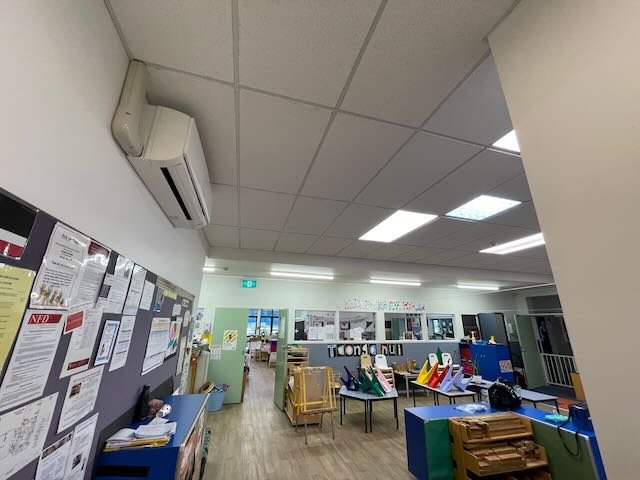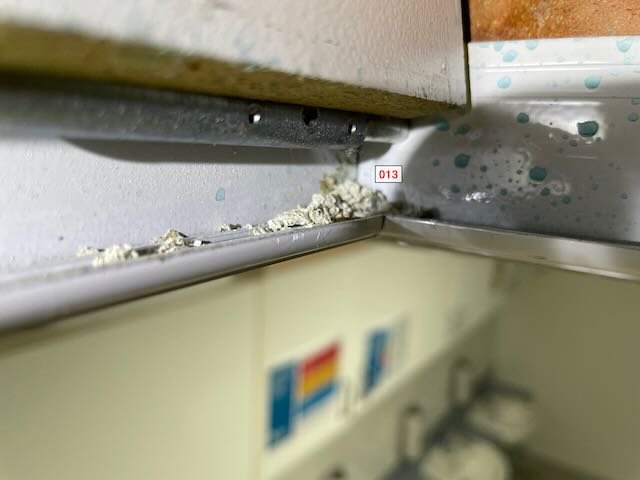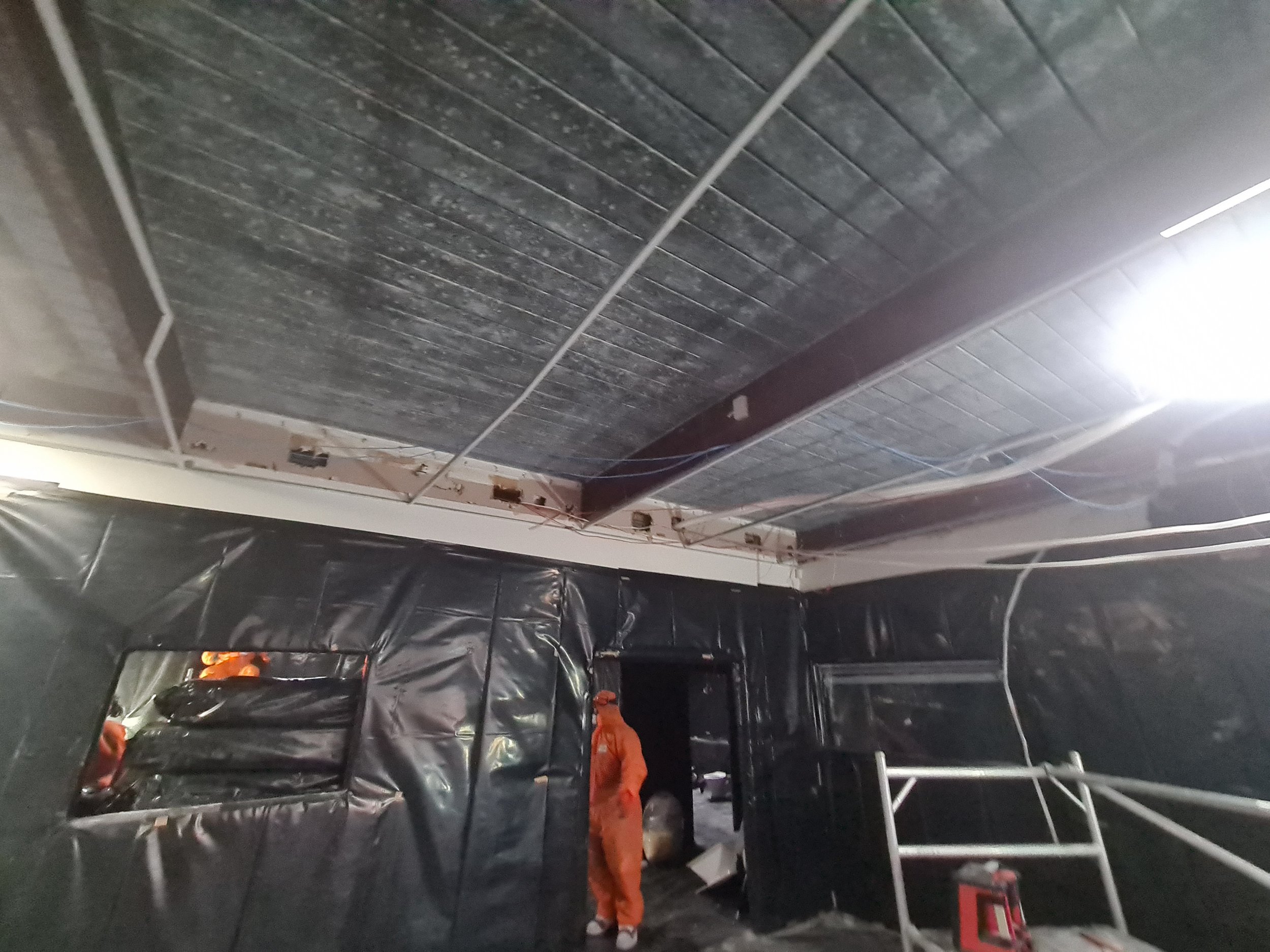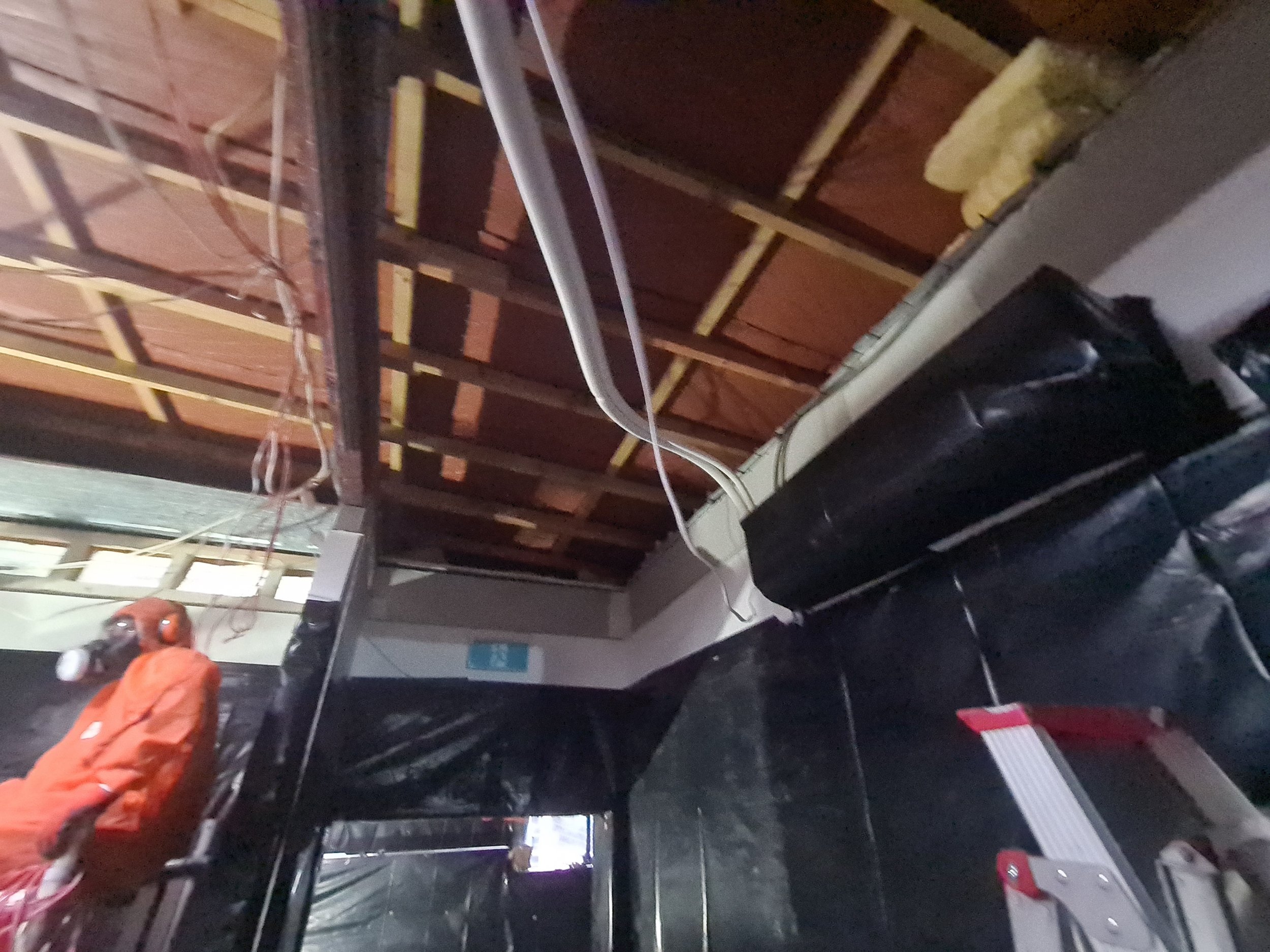Peek behind the scenes of asbestos removal project management
Join us behind the fencing of a project we recently managed….
Humans are naturally curious. So when we see fencing around a building site, of course we are interested about what is going on. Especially if it is a building we pass often.
Let us take you through the steps of this tricky job and how we kept the work on schedule, on budget and safe. Watch the short video below and scroll down to read more detail.
Peek behind the scenes of one of the asbestos projects we recently managed.
The Asbestos Survey
We were engaged to carry out a survey prior to refurbishment of areas of this property so any asbestos could be identified and safely removed. This site already had an asbestos management survey so we were mostly looking for hidden asbestos.
During the survey, we came across the original roof deck. There were white residues with bluish globs of encapsulant pooled on the surface. On closer inspection, we realised that there must have been a popcorn ceiling that had been scraped and then sprayed with a sealant. The first area we looked wasn’t too bad, but we knew there would be need for better removal.
However, as the survey progressed, we found there was more than residues. There were sections where the popcorn coating was still intact. There was this asbestos containing material in the joins of the old roof deck. There was debris on the ceiling track.
So we knew there was going to be a sizable removal job to get rid of it all. Our clients engaged us to manage the project from beginning to end.
Photos left to right: the area when we first got to site; the residues on the old ceiling deck; popcorn in the joins and the section that had not previously been scraped - note the bluish globs from the previous work; popcorn debris on the suspended ceiling track - this would be easily disturbed so would have needed removal immediately, even if there was not a project happening. Keep reading to see the final results!
Procuring an Asbestos Removal Contractor
The first thing we did as project managers was to prepare the technical specification. This is a document we use for tendering. We detail the scope of the removal work, the location and the site specific considerations the asbestos removal contractor needs to know for pricing the job.
Technical removal specifications are an important step if you want your project to meet a budget and/or specific timeline. They are very useful for large or complicated projects, but even smaller projects benefit from a good scope. It also means the tender responses are consistent and there is less variation with what has been quoted. This helps the client compare ‘apples with apples when choosing which quote they prefer.
We then issued the technical removal specification to three asbestos removal contractors. As part of our service, we evaluated the quotes and gave them to our client to review. As the client needed a fast turn around, they selected an asbestos removal contractor we had already pre-qualified. Pre-qualification meant that we had already carried out due diligence on the contractor, offering the client a greater level of certainty that the work would be done right. We always do due diligence on the asbestos removal contractors when we are managing your projects. We find that setting out the expectations at the beginning of the project helps the whole process run smoother.
We also audit the asbestos removal contractors, which they agree to as part of the contract.
Once all the contracts were signed, the site could be prepared for the work.
Communicating with the key stakeholders
This is an important step. With most sites, there are multiple stakeholders that need to be in the loop. They need to make their own plans so they can continue their business or operations during the asbestos removal works.
One of the (many) bonuses to us managing the project is everyone has one point of contact. This keeps the project running smoothly and means any queries or concerns are dealt with quickly by someone who knows what is going on.
Having our board up with QR codes at the entrance to the site made it easy for anyone coming onto site to sign in, view the documentation and get the contact details for the project managers.
We also communicate progress and any important information to the interested parties. This keeps everyone up to date and happy (hopefully!).
During the Asbestos Removals
This asbestos removal project was Class A meaning the asbestos containing materials to be removed were friable. Friable asbestos containing materials have a high potential for fibre release, especially when it comes to removal. So the control measures are comprehensive.
The asbestos removal contractor that was selected by the client to complete the project notified Worksafe Mahi Haumaru Aotearoa and prepared their Asbestos Removal Control Plan (ARCP). They then submitted the ARCP to us to review. We compare it against the technical specification and make sure the removals will cover everything that needs to be done and will be compliant.
First day on site, we got everyone together to make sure we all understood our roles. This is an important step when there are multiple PCBUs (duty holders) on a project. We are all responsible for the health and safety elements of the work so we work collaboratively to ensure nothing falls through the gaps.
The site is then prepared and the asbestos removalists can start setting up the removal area and the rest of the work area. This can take a while. A good set up makes for a straightforward removal process. It is really important that the asbestos removalist secures the site to protect the public. That is why the fencing, signage and screens are the first things to go up.
Before the actual removal started, we did the final checks to ensure the enclosure was well built and not going to leak to surrounding areas. This is where we do a smoke test. The enclosure is filled with smoke while people on the outside of the enclosure look for smoke leaking out. This is by far the easiest way to visually inspect for leaks. Any leaks get repaired. The smoke test can be repeated as often as it is needed. Other technical testing was carried out to support the smoke test too.
Then the removal contractors get on with cutting the old roof deck out and cleaning every nook and cranny of the area. We check in daily. This is partly to monitor the progress, but to air monitor outside of the enclosure to make sure no asbestos is leaking out of the controlled area. We audited them during the removal too.
The routine air monitoring happens every day during the asbestos removals. In this project, we had several air pumps spaced around the enclosure to check that all the control measures were working effectively. If at any point the fibre levels are raised, we can quickly investigate the reasons for higher fibre levels and implement more control measures. These air monitoring results were communicated to the key stakeholders regularly.
Photos left to right: the removalists scraped the popcorn before cutting out the old roof deck; partway though, you can see the new roof deck exposed; all the existing services and wiring was cleaned as part of the removal. If you’ve read this far, you’re going to love the results!
Nearing the End….
Once all the asbestos had been removed, all the waste taken away and the surfaces had been thoroughly cleaned of dust, we carried out our clearance inspection.
For asbestos removals where there has been a negative pressure enclosure (so Class A removals), there must be a four stage clearance carried out by a Licensed Independent Asbestos Assessor. The four stage clearance includes comprehensive inspection of all surfaces in the work area, the removal area and the waste and any transit routes. We inspect every centimetre of the enclosure, including any equipment like mobile towers and ladders. We want to see nothing! As in no dust, no debris, no cobwebs, no residues….
Once we are satisfied there is no visual sign of asbestos, we check for the invisible stuff. This involves us setting up air monitoring pumps inside the enclosure and using a brush to disturb any unseen fibres clinging to the surfaces. We also take surface samples for bulk analysis. Our pumps usually run for an hour. Once the pumps have finished their run, we collect the sampling cassettes and take them to the lab for fibre counting. If the fibre levels come back above the trace level (as in 0.01 fibres/ml or higher if you are interested, <0.01f/ml is the trace level), then the enclosure gets cleaned again and we repeat the visual inspection and air test until….
…..Success! The air sampling results come back as below the trace level, the enclosure can be carefully taken apart and prepared for the final inspection. The surface samples also were useful to support air monitoring results and validate the cleanliness of the remaining timber.
The final inspection we (the independent assessors) make sure that all trace of the removal has gone. All the polythene, tape, staples, waste, equipment, barriers and signage have been packed up and taken away from site.
We can then issue the clearance certificate. NEVER GO BACK INTO AN AREA UNTIL THIS CERTIFICATE HAS BEEN ISSUED!!! It is so important that you wait to go back into the removal area until you have read the clearance certificate. There might still be asbestos so you need to read the certificate carefully. If you are handing the area over to other contractors, like tradies or builders for the next phase pf work, they need to read and understand the clearance certificate alongside all the other asbestos documentation.
Closing Out
At the end of the project, we reviewed all the KPIs with our client and were able to show them how the project kept to budget and timeframe. They had the opportunity to feed back to us what they thought (they were thrilled by the way) and they were able to continue with the next stage of the refurbishments and reinstatement knowing that the areas were safe.
This project was such a great example of the end to end service we love providing to our clients. We have a good number of these under our belts and each time we deliver a project like this, we feel such a sense of achievement for helping our clients through what can be a stressful and confusing process.
Do you need help with your next asbestos project? Use our knowledge and experience to lead you through the process. Get in touch to find out more:









